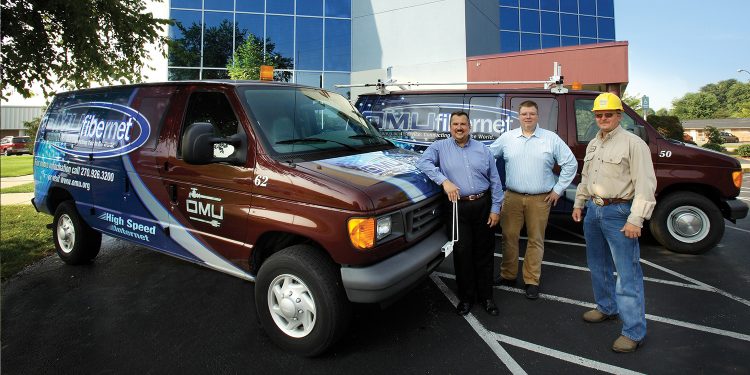In today’s culture, reliable internet seems as essential to a business as water and electricity. Companies rely on a fast, dependable internet access to the extent that the Federal Communications Commission has now classified internet as a utility.
You may have recently heard about Owensboro Municipal Utilities’ fiber services, but the local utility has offered the service to business customers since 1997. In fact, Owensboro now serves as an example to other cities across the commonwealth.
“Other communities are just now struggling by trying to build what we already have,” said Christopher Poynter, Telecommunications Superintendent at OMU. “We have more than 100 miles of fiber currently serving our community, and that’s one heck of an economic development tool.”
After a review and update of its competitive pricing structure, the newly branded OMUfibernet also grew to include phone services. This was a direct result of OMU wanting to provide the services their customers needed.
What is OMUfibernet?
OMUfibernet offers a variety of services including internet, phone, and advanced data services for commercial customers. It uses both Active Ethernet and Gigabit Passive Optical Networking (GPON) to deliver those services.
Public Relations and Communications Specialist, Sonya Dixon, says OMU was very forward-thinking when it identified a need for fiber optic lines and installed the initial ring of fiber around Owensboro in 1997. Initially it was constructed to serve OMU itself as well as City of Owensboro facilities, but the utility knew that it was a service necessary for current businesses to grow. As technology has improved since then, the infrastructure was already there, ready to be built upon and expanded.
Why fiber?
There are many benefits to using fiber optics.
It’s “future proof.” Coax has weaknesses. Wireless has security issues. But the fiber optics being used today will only be enhanced as technology continues to improve in the coming decades.
It’s durable and dependable. OMU fiber run along Tamarack Road withstood the T2K tornado and was not damaged by the OMU trucks that ran over downed fiber optic lines.
The reason for that durability is the way the fiber optic cable is structured. The outer covering is only the first protective layer. Kevlar fibers wrap the inside, offering a second. Four buffer tubes form another plastic sheeting around each of the color-coded fiber bundles. The color coding itself is an additional shield around the fiber bundles. Inside the bundle, each individual fiber is about the width of a human hair. A strength member along the top of the cable keeps the tube rigid so the cable can be suspended without sagging.
“As an added bonus,” Dixon explained, “it is provided by your local utility. One local phone call connects you directly to the personnel and system experts that will not only work with you to determine your needs, but provide responsive assistance as you need it.”
OMUfibernet Technology:
Fiber is physically secure, is highly resistant to outside interference, lasts for decades, and is the medium of choice for researchers seeking to expand the boundaries of data transmission in the future.
The real beauty in this technology, according to Chris Poynter, is that once the fiber is in place it can be used for decades to come. It’s as simple as switching out the electronics at each end to facilitate upgrades.
“That’s why that initial investment to go with fiber was so important. We knew it had that flexibility,” Dixon added.
What does this mean for your business?
High-speed, affordable internet that is dependable and reliable. “For us, it’s about meeting the needs of our customers,” Dixon said. “We serve everyone from ‘mom and pop’ businesses to large industries, and we’re very proud that we have the capability to do that.”
Getting the service at your office or business is as easy as a local phone call. A technician will help you determine what you need and walk you through the entire process.
For pricing and other information, visit OMU.org or call 270-691-4668.
This article appeared in the 4th Quarter issue of GO Business Magazine.
In case you’re wondering – home service, or Fiber To The Home (FTTH) is still in the beginning stages. OMU is starting a pilot project on 558 homes the Town & Country neighborhood in January. That area was chosen for several reasons: it’s close to where the equipment is, the neighborhood has both aerial and undergournd services, and there diverse residential properties in that area. Customers in the pilot area can visit omu.org for more information and express their interest in the service by registering for the pilot.










